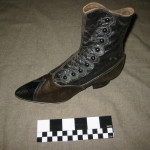Until 1900, when the first general store opened in Jackson, if early homesteaders needed clothing they had to travel two weeks over the Teton Pass to Idaho, or make it themselves. Most chose to make their own clothing, and it was a point of pride for many women. Lengths of fabric would need to be purchased and brought over the Pass, but it was a daily chore in most cabins to repair and make the family’s clothing, bedding, pillows and wall or ceiling covers. When travel conditions permitted, women would gather in a neighbor’s front room and compare their sewing talents either by mending clothing or making quilts. Quilts in particular were a focus of these social gatherings, as they were necessary for cool summer and frigid winter nights. Even in midsummer, temperatures at night in Jackson Hole could reach the 30s.

An unidentified woman with a classic “Victorian waist.”
Despite living in an isolated mountain valley, the female residents were very aware of national fashion trends. During the 1890s, a skinny Victorian waist was in vogue, and many women tailored their dresses to make their waists appear thinner. It was a point of pride for many valley women to take on any of the chores of their male counterparts, in a corset and full skirts. As for Melvina, she would have been clothed in a dress with skirts that just touched the floor, made from gingham or calico fabric. Alpaca, wool cashmere, linsey and brilliantine fabrics were reserved for formal wear. Ruffles around the sleeves and neck added some decoration, and allowed for individuality to show through. Women during this time often wore two petticoats to make the skirts appear fuller, and the waist thinner. This may seem like an excessive amount of layers, but it was necessary for the long winter months, and even summer weather could be unpredictable in the valley. Socks and stockings were knitted, and long underwear was made from a heavy cotton flannel. Miller’s linen or unbleached muslin was worn under the clothing during the summer, and also used for pillows, bedding and wall or ceiling covers.

An early hair curling iron. This one has a wooden handle for safety, most had iron handles and needed to be held with fabric.
Shoes were another matter, and these were something of a luxury item if purchased new. For many families, they made and repaired their shoes as needed. Many individuals had only one pair, and perhaps a second pair that was rarely worn except for special occasions. When the soles or shoe uppers wore out, new leather (often from elk or deer hides) was tanned to replace the worn-through parts. Women’s shoes were heeled, and often buttoned or laced past the ankles. Men wore low-heeled boots. Melvina’s mother Mary learned how to make moccasins from Millie Carnes, who was half-Ute and had learned the craft from her full Ute mother. The children wore moccasins in the summer, which saved their hard leather shoes for winter. Buckskins were also made for the men to wear in the summer, to save their hardier cotton flannel and leather jackets for winter.
- An example of women’s boots.
- An example of men’s boots.
While the dresses of early Jackson Hole homesteading women may not have been as high-fashion as they liked due to cost and practicality, they were still proud of their appearance. Hair could be curled around heated iron spikes, or tied up in cloth rags or old papers. As time progressed, divided riding skirts were invented so that women could separate their skirts to ride astride the horse. These were voluminous enough when walking that the casual observer would not notice the division. Some models had buttons to unify the separate pieces.
Continue on to COMMUNITY GROWTH





